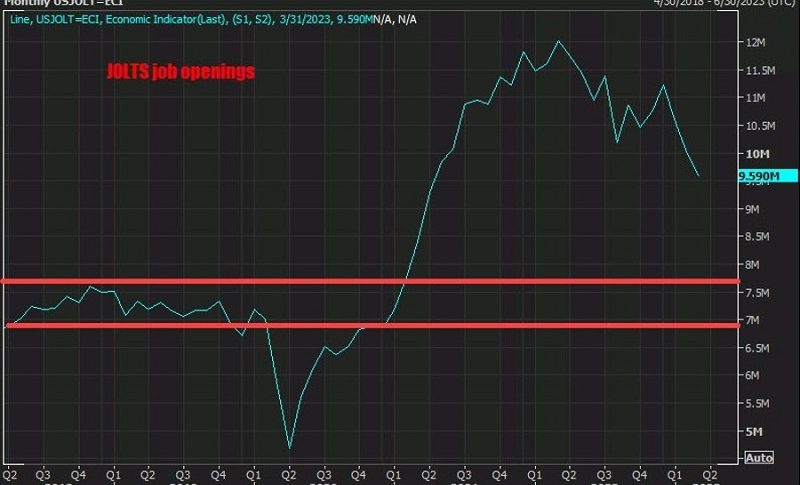USD Dips After Another Soft JOLTS Jobs Report
EUR/USD has jumped 40 pips higher after another soft JOLTS job openings report for March, showing a slowdown in the labour market

The USD has been bearish in recent months as the FED prepares to stop rate hikes after the last 25 bps hike tomorrow. Economic figures have been softening, with CPI inflation heading toward 5%, while now employment is showing signs of weakness as well.
The last JOLTS job openings report showed that new jobs fell below 10 million in February for the first time since May 2021. Although markets took it with a pinch of salt, expecting jobs to recover again above 10 million. But, today’s report showed another weak month, with jobs remaining below 10 million and missing expectations as well.
EUR/USD H1 Chart – Will the 50 SMA Hold As Resistance?

The trend seems to be changing for EUR/USD
EUR/USD was bearish since early March, as the FED softened the rate hike rhetoric, while the ECB is expected to continue raising interest rates. But, since the last week of April we have seen a reversal, with the highs getting lower on the H1 chart, while moving averages are turning into resistance. We saw a 40 pip jump after the JOLTS jobs report but the climb has stalled and we decided to open a sell EUR/USD signal just a while ago.
JOLTS Job Openings for March 2023
- JOLTS job openings for March 9.595M vs 9.775 million estimate
- JOLTS job openings for February
- Job openings decreased to 9.6 million on the last business day of March, down by 384,000 and 1.6 million lower than in December.
- Job openings rate was 5.8% in March, down by 1.0 percentage point since December.
- Job openings decreased in transportation, warehousing, and utilities (-144,000) but increased in educational services (+28,000).
- Hires remained stable at 6.1 million, with a rate of 4.0%.
- Hires decreased in real estate and rental and leasing (-29,000).
- Total separations (5.9 million) and the rate (3.8%) remained stable for the fourth month in a row.
- Total separations decreased in accommodation and food services (-107,000) but increased in construction (+104,000).
- Quits remained stable at 3.9 million, with a rate of 2.5%.
- Quits decreased in accommodation and food services (-178,000).
- Layoffs and discharges increased to 1.8 million (+248,000) with a rate of 1.2%.
- Layoffs and discharges increased in construction (+112,000), accommodation and food services (+63,000), and health care and social assistance (+42,000).
- Other separations remained stable at 276,000, decreasing in finance and insurance (-31,000) and real estate and rental and leasing (-7,000).
The trend is to the downside for JOLTS, but is still well up from the pre-pandemic levels which were centered around 7 million to 7.5 million. There are theories that the number has been gamed by companies who post jobs but are really not filling them (or in need). Working through what is true and not is difficult, however.
Quits are watched for trends. If quits increase it shows that employees most likely are confident of getting another job. The quits remained steady at 3.9M.
EUR/USD Live Chart
- Check out our free forex signals
- Follow the top economic events on FX Leaders economic calendar
- Trade better, discover more Forex Trading Strategies
- Open a FREE Trading Account


